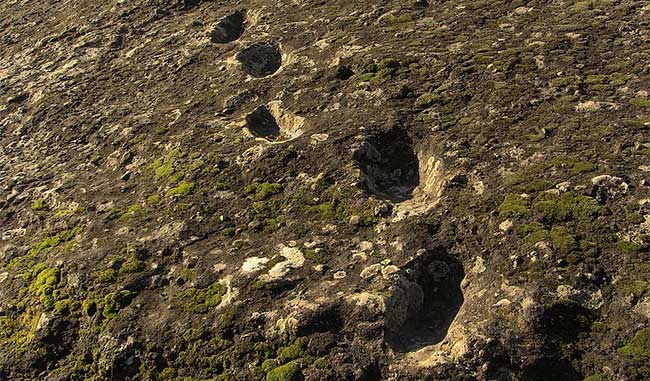Whose fossil footprints on Roccamonfina volcano are?
Coming down from the slopes of Roccamonfina volcano in northern Italy, human footprints have long been considered a demon's footprint, because these footprints originate from the top of the molten volcano. So can anyone but the devil walk on the lava flow without burns his feet?
Since the discovery of ancient footprints in the late 18th century, locals have assumed that the footprints were evidence that the demons that once emerged from hell through the crater had turned off and wandered on. Earth. That's why they gave it the name Ciampate del Diavolo, or "Footprint of the Devil".
Accordingly, fossil footprints and several handprints were discovered from the villages of Tuoro, Foresta and Piccilli in Campania, Italy. Those who do not believe them are traces of demons who think they are traces of ancient animals.

Experts believe that these marks are even clearer because of the volcanic lava flow.
However, researchers from the University of Padua have confirmed they are of human origin. They determined this was likely a trace dating back some 350,000 years to a bipedal hominid. It is also believed to be the oldest "human" footprint outside Africa, until the 800,000-year-old "Happiburgh" footprint was found in Britain in 2013.
Ancient human footprints were rarely well preserved in an open environment. Experts believe that the traces were even clearer because of the volcanic lava flow - often consisting of ash, pumice stone and rock fragments - which were then coated with volcanic ash.
Scientists from Padua University also demonstrated that the thick layers of sediment buried the footprints. It was not until the end of the 18th century and the early 19th century that erosion revealed footprints and it was discovered.
Among the remarkable features of the Devil's Footprint, the most prominent feature is the occasional handprint found next to the footprints on the cliff face of the volcano. This suggests that the traces created by upright hominids but need to stabilize themselves when they are down a dangerous slope.
This hypothesis is supported by evidence that the ancients carefully chose the path down the ridge. Some go in a Z-shape, while some go straight. These people just walk, not run.
The researchers believe that the owners of these traces are completely bipedal hominids with free gait (meaning they walk entirely with their feet and only use their arms to support or regain balance). .
And most likely, these footprints were created by prehistoric Homo Erectus or Homo Heidelbergensis in late Europe. With footprints about 8 inches (about 20cm) wide and 4 inches (10cm) wide, the average stride was about 4 feet (1.2 m), experts concluded that prehistoric humans left the footprints mentioned above. only about 5 feet (1.5m) tall.
To this day, we still don't know and probably never know what prehistoric people did on volcanoes, and how could they go down the mountain when the volcano was erupting?
Although the Devil's Footprint is Homo's oldest preserved footprint, they are not the oldest ape footprint; That honor belongs to the famous Laetoli footprint in Tanzania, the remains of 3.5 million years ago.
- Found 400 human footprints intact 19,000 years ago
- Rumored footprints from demons around the world
- Discover the oldest fossil animal footprint ever
- Discover fossil giant footprints in Western China
- Large fossil dinosaur footprints discovered
- The largest fossil animal population
- Discover the smallest dinosaur footprint ever
- Discover the most mysterious, ancient and mysterious
- Find fossil tracks of 3 duckbill dinosaurs
- Discover cliffs with more than 5,000 ancient dinosaur footprints
- Discover strange creatures footprints 310 million years ago
- Discovered several hundred dinosaur footprints in Beijing
 Discovered an ancient centipede fossil 99 million years old
Discovered an ancient centipede fossil 99 million years old Discovered bat-like dinosaurs in China
Discovered bat-like dinosaurs in China Discovered a 200-year-old bronze cannon of the coast
Discovered a 200-year-old bronze cannon of the coast Discover 305 million-year-old spider fossils
Discover 305 million-year-old spider fossils